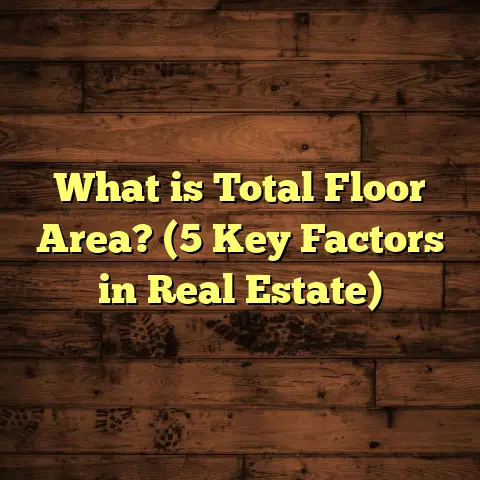What is Floor Leveler Made Of? (5 Key Materials Explained)
I remember the first time I tackled an uneven floor in a client’s home. The before scene was rough: jagged patches, dips, and cracks that made it impossible to lay down any kind of flooring properly. It was frustrating for the homeowner and honestly, a bit of a headache for me. But after applying a quality floor leveler? The transformation was incredible. The surface became smooth, strong, and ready for hardwood or tile without any worries. That “after” scene is what every flooring project deserves.
What Is Floor Leveler?
So, what exactly is floor leveler? Simply put, it’s a material used to create a flat, even surface on floors that are uneven or damaged. Think of it as the base coat before you add your final flooring layer. The job of a floor leveler is crucial because it ensures that the flooring above—whether it’s hardwood, vinyl, or tile—lays down perfectly without bumps or gaps.
Floor levelers come in several varieties, each designed to meet specific needs. They can fill cracks, smooth out rough patches, and even raise low areas. I’ve worked with many types over the years, and understanding what they’re made of helps me pick the right one for each job.
Let me share some reasons why floor levelers matter so much.
Why You Need a Floor Leveler
Uneven floors can cause all sorts of problems. Have you ever noticed how some floorboards creak or how tiles crack or pop loose over time? Most of the time, that comes down to the subfloor not being flat or stable. If you install flooring on a surface with dips and bumps, it won’t last long. It could also be unsafe—tripping hazards are real.
When I first started out, one of my clients ignored these issues and wanted to install a hardwood floor directly over a rough concrete slab. It didn’t take long before they called back complaining about squeaks and uneven boards. Applying a floor leveler fixed all that by creating a smooth foundation.
Five Key Materials Used in Floor Levelers
Now, let’s get into the heart of it: what floor levelers are made of. Over the years, I’ve used five main types depending on project needs: cement-based, gypsum-based, polymer-modified, self-leveling compounds, and epoxy-based.
1. Cement-Based Floor Leveler
Cement-based floor levelers are probably the most common you’ll see on job sites. They’re made with Portland cement mixed with fine aggregates like sand and sometimes additives that improve workability or drying.
Why I like it: Cement-based levelers are incredibly strong once cured. Their high compressive strength (usually between 3,000 to 5,000 psi) means they can withstand heavy foot traffic and even furniture movement without cracking or crumbling.
A bit of science: Portland cement hydrates when mixed with water. This chemical reaction makes the material harden and gain strength over time. Additives can speed up drying or improve adhesion.
My experience: On a kitchen remodel a few years ago, the concrete slab had many dips and small cracks from years of wear and water exposure. Using a cement-based floor leveler allowed me to build up low spots and patch cracks easily. It took around 24 hours to dry enough for me to install hardwood on top.
What about thickness? Cement levelers work great when applied at thicknesses from about 1/8 inch up to 1 inch or more. But if you try to apply too thinly (under 1/8 inch), they may crack as they dry too quickly or shrink unevenly.
A downside: They aren’t very flexible. If your subfloor moves or expands (like wood does), cement levelers might crack over time.
2. Gypsum-Based Floor Leveler
Gypsum-based compounds use gypsum plaster combined with polymers and fillers to create a smooth leveling paste.
Why choose gypsum? These levelers dry faster than cement ones—sometimes setting in just 20 to 30 minutes—and provide a silky smooth finish great for thin layers.
Data I found: Gypsum compounds have compressive strengths around 1,500 to 3,000 psi—less than cement but enough for many residential floors.
My story: One time, a homeowner needed new vinyl flooring installed quickly in their hallway before a family event. Using gypsum-based floor leveler meant I could prepare the floor early morning and have it ready for vinyl installation by afternoon.
But watch out: Gypsum is sensitive to moisture. It can degrade or lose strength if exposed to water or high humidity environments like basements or bathrooms without proper sealing.
Thickness range: Gypsum levelers excel at thin applications – often from just 1/16 inch up to 1/4 inch thick.
3. Polymer-Modified Floor Leveler
Polymer-modified floor levelers are usually cement or gypsum mixes enhanced with polymers like latex or acrylic.
Why polymers? Adding polymers improves flexibility and bonding strength while reducing cracking risk caused by shrinkage or movement.
From my toolbox: In homes with plywood subfloors or old tiled floors that need leveling before new flooring, polymer-modified products have been lifesavers. They stick better and move with the floor rather than cracking apart.
Strength stats: Polymer-modified mixes generally reach compressive strengths similar to cement-based levelers but with better impact resistance and elasticity.
Example: A historic house renovation required me to level wooden subflooring with irregularities caused by settling over decades. The polymer-modified mix gave me confidence it wouldn’t fail as wood expanded or contracted seasonally.
Cost factor: These tend to be pricier than basic cement or gypsum levelers but often reduce labor from repairs later on.
4. Self-Leveling Compounds
Self-leveling compounds are designed to flow out and settle flat on their own with minimal manual spreading. They are typically cementitious or gypsum-based but formulated with special additives for fluidity.
Why they’re great: They drastically reduce labor since you pour them on and let gravity do most of the work leveling the surface.
My favorite projects: For large rooms like living rooms or basements where level surfaces are essential for laminate or tile installation, self-leveling compounds save hours compared to hand-troweling regular mixes.
Drying times: Many self-leveling compounds set hard within 2-4 hours and fully cure in 24 hours, speeding up project timelines significantly.
Did you know? Self-leveling compounds typically require priming the subfloor first to ensure proper bonding and prevent air bubbles beneath the surface.
A word of caution: Mixing consistency is crucial here—a little too watery or too thick will cause problems like cracking or uneven finish.
5. Epoxy-Based Floor Leveler
Epoxy floor levelers use resin and hardener mixtures that cure chemically into an extremely tough surface.
When I use epoxy: Mostly industrial floors like warehouses or garages where chemical resistance and durability matter most.
The science behind it: Epoxy cures through a chemical reaction between resin and hardener molecules forming strong cross-links that resist wear, chemicals, and moisture better than cement or gypsum mixes.
My experience: A commercial client needed an ultra-durable showroom floor that would resist spills and heavy foot traffic. Epoxy leveling combined with an epoxy topcoat gave them years of trouble-free service.
Drawbacks: Epoxy application requires careful mixing, ventilation due to fumes, and can be expensive compared to other types.
Comparing These Options: What Works Best When?
Over my years on the job, I’ve learned there’s no one-size-fits-all answer here. The best floor leveler depends on where you’re working, how much leveling is needed, budget, and your timeline.
| Material Type | Drying Time | Strength | Moisture Resistance | Cost | Best Use Case |
|---|---|---|---|---|---|
| Cement-Based | 4-24 hours | Very strong (3000-5000 psi) | Moderate | Low to medium | Heavy traffic, concrete floors |
| Gypsum-Based | 20-30 minutes | Moderate | Poor | Low | Quick indoor projects |
| Polymer-Modified | 2-6 hours | Strong + flexible | Good | Medium to high | Wood subfloors, tricky surfaces |
| Self-Leveling Compound | 2-4 hours | Moderate to strong | Moderate | Medium | Large areas needing smooth finish |
| Epoxy-Based | 12-24 hours | Extremely strong | Excellent | High | Industrial/garage floors |
I’ve seen cases where people picked gypsum for basement floors only to face crumbling later due to moisture. And I’ve also had clients who saved time using self-levelers but later regretted skimping on surface prep because adhesion suffered.
How Thickness Affects Your Choice
Thickness plays a big role in which floor leveler you pick:
- Thin layers (less than 1/4 inch): Gypsum-based or polymer-modified are often best.
- Medium thickness (1/4 inch – 1 inch): Cement-based or self-leveling compounds shine here.
- Thick builds (over 1 inch): Cement-based mixes usually preferred due to strength.
- Specialty surfaces: Epoxy for chemical resistance and heavy-duty floors.
Subfloor Types Matter Too
The kind of surface beneath your floor is another huge factor:
- Concrete slabs: Cement-based or self-leveling compounds bond well.
- Plywood/wood: Polymer-modified recommended due to movement.
- Old tile: Polymer-modified or epoxy can adhere better.
- Radiant-heated floors: Flexible polymer-modified products protect pipes from pressure changes.
Real Case Studies From My Work
Case Study #1: Historic Home Wood Subfloor Leveling
In an old house built in the early 1900s, I faced uneven wooden subfloors with many dips caused by settling over decades. The owner wanted new hardwood floors but worried about squeaks and cracks later on.
I chose polymer-modified floor leveler because its flexibility accommodates wood movement better than rigid cement mixes. After applying two coats with light sanding between them, the surface was perfectly flat yet resilient to expansion changes throughout seasons.
This approach prevented cracks I’d seen before in similar projects using cement-only products on wood subfloors.
Case Study #2: Commercial Showroom Flooring
A client needed a showroom floor with heavy foot traffic and occasional chemical spills from cleaning agents. Time was tight; they wanted the floor ready in under two days.
We used epoxy-based floor leveler combined with an epoxy topcoat sealant. Although costlier upfront, this solution provided unmatched durability and moisture resistance. The client reported zero issues even after three years despite constant use.
This project showed me how specialized materials bring long-term value when matched well to needs.
Case Study #3: Quick Vinyl Flooring Prep
A mom renovating her kitchen wanted quick results so her family could enjoy the new space fast. The concrete subfloor had minor dips but no major damage.
I applied gypsum-based floor leveler because it dries rapidly—ready for vinyl within hours instead of days. The installation went smoothly and the family was thrilled with their new floor just in time for a weekend gathering.
Additional Tips From My Experience
Always Prepare Your Subfloor Properly
No matter what material you use for leveling, prepping the subfloor is critical. This includes cleaning thoroughly, removing loose debris, filling large cracks first, and sometimes priming the surface so the leveler bonds well.
Skipping prep often leads to peeling or cracking later on—even if you picked the best product.
Mix Exactly As Directed
Many problems arise when installers don’t follow mixing instructions closely—too much water weakens strength; too little makes application difficult. I always measure water precisely and use proper mixing tools for consistent batches.
Consider Environmental Conditions
Temperature and humidity affect drying times dramatically. For example:
- Cold weather slows curing; sometimes additives help speed this up.
- High humidity can trap moisture inside the leveling compound causing longer dry times or weaker strength.
Adjust your schedule accordingly!
Some Industry Data That Might Surprise You
- According to a recent survey by Flooring Today magazine (2023), nearly 70% of flooring failures can be traced back to poor subfloor preparation—including improper leveling.
- Cement-based leveling compounds represent about 60% of all sales worldwide due to their balance of cost and strength.
- Polymer-modified products have grown steadily in popularity by roughly 10% annually as more contractors seek flexible solutions.
- Self-leveling compounds reduce labor costs by up to 50%, saving thousands on large projects.
- Epoxy-based leveling compounds still make up less than 5% of total market share but have seen steady growth in industrial sectors over the past decade.
How Do You Pick?
Ask yourself:
- What kind of subfloor am I working on?
- How uneven is the floor? Are there deep dips or just minor bumps?
- Will there be moisture exposure?
- What’s my deadline?
- How much am I willing to spend?
Answering these will narrow down your choices sharply.
Final Thoughts From My Toolbox
Floor levelers are unsung heroes in flooring projects. Without them, even the fanciest hardwood or tile won’t look right or last long. Each material has pros and cons based on strength, drying time, flexibility, cost, and environment suitability.
If you’re DIYing your project or hiring pros, knowing what floor leveler is made of helps you make smarter choices—and avoid costly mistakes later on.
For me personally, polymer-modified compounds have become my favorite go-to because they handle most situations well without breaking the bank or extending timelines unnecessarily.
Got questions about your floor leveling project? Ask away—I’m happy to share what I’ve learned firsthand!





